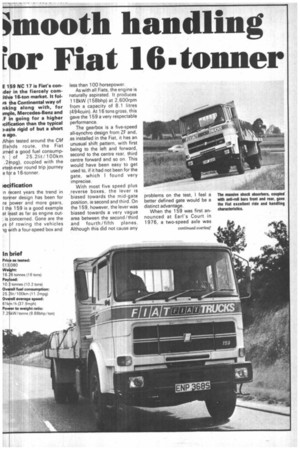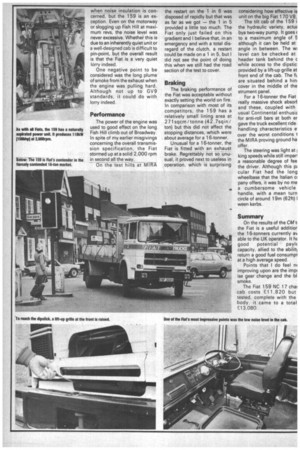mooth handling r Fiat 16-tonner
Page 31

Page 33

Page 34

If you've noticed an error in this article please click here to report it so we can fix it.
E 159 NC 17 is Fiat's conAO in the fiercely corniti e 16-ton market. It fole Continental way of nk ng along with, for im le. Mercedes-Benz and n going for a higher cif cation than the typical )-a le rigid of but a short e a o.
n tested around the CM Jla ids route, the Fiat rnt d a good fuel consump
of 25.2Iit/ 100km .2 pg), coupled with the )rte t-ever round trip journey e f r a 16-tonner.
ecjfication n recent years the trend in .tonner design has been for re power and more gears, I th 159 is a good example at last as far as engine outis oncerned. Gone are the vs f rowing the vehicles ig ith a four-speed box and
less than 100 horsepower.
As with all Fiats, the engine is naturally aspirated. It produces 118kW (158bhp) at 2,600rpm from a capacity of 8.1 litres (494cuin). At 16 tons gross, this gave the 159 a very respectable performance.
The gearbox is a five-speed all-synchro design from ZF and, as installed in the Fiat, it has an unusual shift pattern, with first being to the left and forward, second to the centre rear, third centre forward and so on. This would have been easy to get used to, if it had not been for the gate, which I found very imprecise.
With most five speed plus reverse boxes, the lever is biased towards the mid-gate position, ie second and third. On the 159, however, the lever was biased towards a very vague area between the second /third and fourth/fifth planes. Although this did not cause any problems on the test, I feel a better defined gate would be a distinct advantage.
When the 159 was first announced at Earl's Court in 1976, a two-speed axle was continued overleaf raila ble as an option, but Fiat is )w having second thoughts Out this. To date all the 16nne brought to the UK are of e Si Igle-speed variety. I was itiaI y rather dubious about is a the ZF gearbox has some wni rig gaps in the ratios, notIle f om first to second, which leaps from 6,61 to 3.61 in one go.
In fact, on the road, the relatively high power (for a 16tonner) of the Fiat engine and its usable power band of over 1,000rpm covered the gaps very effectively indeed. Thus as far as the Fiat is concerned, a two-speed axle is by no means essential, as it is with many of its competitors.
Economy
The overall fuel consumption figure of 25.21it / 100km (11.2mpg) does not, I feel, do justice to the full potential of the Fiat, due to the strong headwinds encountered on the motorway section. Even so, the motorway figure is still acceptable — it is only poor when compared with the results achieved over the rest of the route.
In the past Fiats have often been criticised because of their apparently high kerb weight. This was unjustified as Fiat is one of the few manufacturers to quote kerb weight complete with a full tank of fuel. The long wheelbase 159, complete with CF Rigids' body, had a kerb weight of 5.75 tonnes (5 tons 13cwt) with nearly 50 gallons of fuel on board, which is certainly competitive on the potential payload score,
Noise
With the 5.125 axle ratio (5.75 is available for the tipper) the 159 had a top speed of 106km /h (66mph) which meant that the engine was doing about 2,200rpm at the legal motorway limit. This leads me on to one of the most impressive points about the Fiat's performance, the in-cab noise level.
It is a fact of life that 16tonners do not usually benefit as much as their 32-ton brethren continued overieaf when noise insulation is concerned, but the 159 is an exception. Even on the motorway or slogging up Fish Hill at maximum revs, the noise level was never excessive. Whether this is due to an inherently quiet unit or a well-designed cab is difficult to pin-point, but the overall result is that the Fiat is a very quiet lorry indeed.
One negative point to be considered was the long plume of smoke from the exhaust when the engine was pulling hard. Although not up to GV9 standards, it could do with lorry indeed.
Performance
The power of the engine was used to good effect on the long Fish Hill climb out of Broadway. In spite of my earlier misgivings concerning the overall transmission specification, the Fiat stormed up at a solid 2,000 rpm in second all the way.
On the test hills at MIRA the restart on the 1 in 6 was disposed of rapidly but that was as far as we got — the 1 in 5 provided a little too much. The Fiat only just failed on this gradient and I believe that, in an emergency and with a total disregard of the clutch, a restart could be made on a 1 in 5, but I did not see the point of doing this when we still had the road section of the test to cover.
Braking
The braking performance of the Fiat was acceptable without exactly setting the world on fire. In comparison with most of its competitors, the 159 has a relatively small lining area at 271sqem /tonne (42.7sqin/ ton) but this did not affect the stopping distances, which were about average for a 16-tonner.
Unusual for a 16-tonner, the Fiat is fitted with an exhaust brake. Regrettably not so unusual, it proved next to useless in operation, which is surprising
considering how effective is unit on the big Fiat 170 V8.
The tilt cab of the 159 i the hydraulic variety, actuE bya two-way pump. It goes c to a maximum angle of 5 although it can be held at angle in between. The w( level can be checked at header tank behind the c 'while access to the dipstic provided by a lift-up grille at front end of the cab. The IL are situated behind a hin, cover in the middle of the strument panel.
For a 16-tonner the Fiat really massive shock absort and these, coupled with usual Continental enthusiz for anti-roll bars at both er gave the truck excellent ride . handling characteristics e. over the worst conditions t the MIRA proving ground ha offer.
The steering was light at king speeds while still impan a reasonable degree of fee the driver. Although this ID( cular Fiat had the long wheelbase that the Italian ci pany offers, it was by no me a cumbersome vehicle handle, with a mean turn circle of around 19m (62ft) I ween kerbs.
Summary
On the results of the CM ti the Fiat is a useful additior the 16-tonners currently av able to the UK operator. It h2 good potential paylc capacity, allied to the abilit) return a good fuel consumpt at a high average speed. Points that I do feel n( improving upon are the imp+ ise gear change and the bl smoke.
The Fiat 159 NC 17 chw cab costs £11,820 but tested, complete with the body, it came to a total E.13,080.




































































































